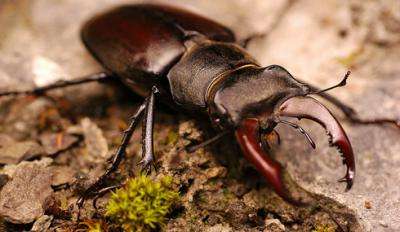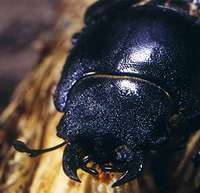Stag beetles take flight, but not for long

(PhysOrg.com) -- About now, and possibly for the next few weeks only, is the time to see the impressive adult stag beetles in flight in the south of England.
Adults of the UK’s largest and endangered terrestrial beetle, Lucanus cervus, live for only a few weeks and the rest of their life cycle is spent underground as developing larvae for a lengthy 4 to 6 years.
In their brief time as adults, they look for mates and desperately search for dead and decaying wood to lay their eggs in, a habitat that has become increasingly rare and has caused their numbers to decline dramatically in the last 40 years.
It’s the adult male beetles that have the striking antler-like mouthparts or mandibles. They can look a little scary but they're only used to warn off other males.
The males can grow to 70mm and the females can be as small as 25mm, although the females are the ones who use their smaller mandibles to bite.
The stag beetle is a protected species and only found in a few areas in southern Britain. Some hot spots include the Thames valley, Severn Valley and parts of the south-west coast.
Sightings of the adults may be becoming rarer, however, the Natural History Museum’s Identification and Advisory Service (IAS) has had its first stag beetle enquiries of the year.
‘We get stag beetle enquiries every year, and they are always positive,’ says Beulah Garner, insect expert in the IAS.
‘In May and June, we had 1 or 2 enquiries a week. Generally people are quite aware of them and aware that they are protected so they ask us what to do when they find them.’
People sometimes find stag beetle larvae, which are creamy white and can grow to a huge 80mm.
Beulah explains one recent enquiry. ‘Last week I spoke to a gardener who had found 4 larvae in her woodpile, and they had to be moved as she was having a fence built.
'We advised her that it was okay to ‘relocate them’ using the soil and dead wood litter she found them in, placing them in shallow soil, underneath or very near to a new pile of dead wood or dead tree stump.’

Another common enquiry, Beulah says, comes from people nervous about telling the female stag beetle apart from the lesser stag beetle, Dorcus parallelipepidus, which isn’t endangered. The main way to tell the difference is the colour of the wing cases - the stag beetles’ are a chestnut red colour, although can be almost black, whereas the lesser stag beetles’ are generally black.
Another way that scientists can check the species is by looking at the number of spikes on the middle of the 3 legs on the tibia - stag beetles have 3 spikes and the lesser stag beetle has 1.
The Museum’s bug forum can help you correctly identify a stag beetle. It has experts giving feedback when you post a message and image. You can then record your sightings online in surveys like the Great Stag Hunt. These records will help with monitoring and future conservation of the species.
Beetles are the most diverse group of organisms on the planet, with over 400,000 described species, and they include ladybirds, weevils, dung beetles and more.
The UK has around 4000 species of beetle. Beetles carry out many crucial roles in nature such as recycling dead wood, dung and the bodies of dead animals, as well as pollinating plants.
It’s commonly thought that stag beetle adults fly between May and August. However, some scientists think this may now be shorter between May and July. This may be due to the fact that there are not as many individuals about any more and so they are seen for a shorter period.
Information about historical flight times, such as when and where a stag beetle was caught or seen flying, can come from notes on specimen labels in the Museum’s collections. There are nearly 9 million beetle specimens in the Coleoptera collection and some are hundreds of years old.
Stag beetles need dead and decaying wood to lay their eggs and to feed on, so leave an area of your garden undisturbed with fallen trees, tree stumps or logs that are in contact with the soil (so that the wood remains moist and can decay).
This kind of habitat is good for other wildlife as well, but if you are lucky enough, you may help these magnificent stag beetles move in too.
Provided by American Museum of Natural History















